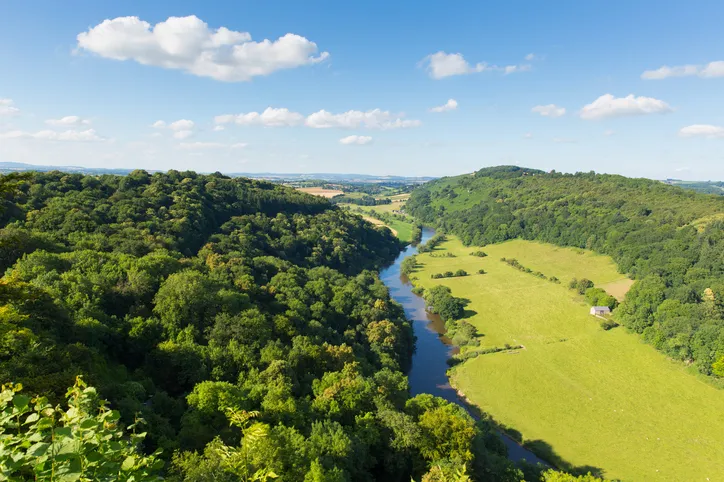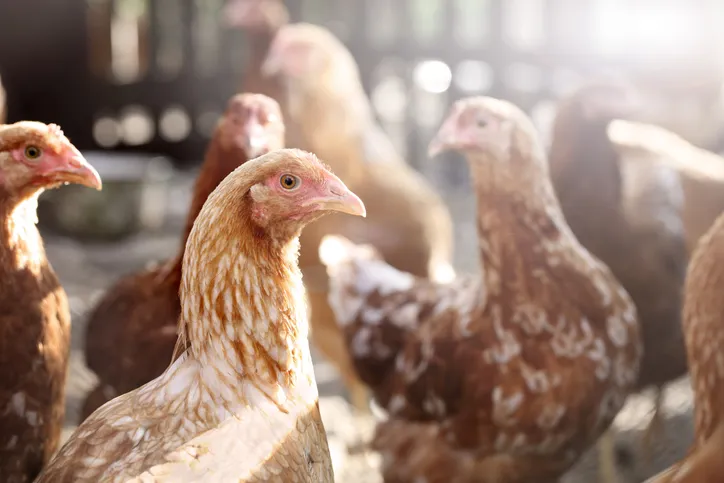The number of chickens raised in intensive poultry units (IPUs) needs to halve across England and Wales over the next 25 years to save some of the country’s most-loved rivers from ecological death.
So says the UK’s leading organic farming group, the Soil Association, which has revealed in a new report that roughly 1 billion chickens pass through these units every year. In the past decade, the number of birds farmed for their meat has grown by more than 160 million, equivalent to an increase of 1 million every month.
Intensive chicken rearing produces thousands of tonnes of phosphate-rich manure every year, and much of this is spread on fields surrounding the farms and then leaches into rivers. The corresponding influx of nutrients causes algal blooms that deprive other organisms in the water of oxygen and creates a thick blanket that deprives plants of sunlight.
The River Wye, on the England-Wales border, has been particularly badly impacted. In 2020, an algal bloom killed off wildlife below the surface for more than 220km (140 miles), with water crowfoot completely eradicated over 110km.
- What's next for AI in farming
- Do farmers have a responsibility to maintain footpaths on their land?
- Striving towards net zero on the farm

As a first step the Government should not give permission for any more broiler chicken units, the association says, and then it must address ways in which farmers can find more environmentally friendly ways of producing food. It also needs to reduce chicken (and, indeed, all meat) consumption within the UK and encourage people to adopt more plant-based diets.
“By 2050, we need to reduce numbers by around half of what we are currently eating,” said the Soil Association’s campaigns coordinator Cathy Cliff. “That means 50 per cent less chicken in the average diet and correlated declining poultry populations.”
Roughly 1 billion chickens are raised in intensive poultry units every year, according to the new Soil Association report.
Poultry consumption in the UK has nearly doubled in the past three decades, from an average of 16kg per person per year in 1990 to more than 30kg per person in 2023, according to the Soil Association’s new report, Stop Killing Our Rivers. This has happened as a result of the abundance of cheap, largely soya-based chicken feed, which has contributed to the price of chickens more than halving in the past half century.
“Chickens sold for an average 46p in 1971, equivalent to £8.96 today, when the average chicken [now] sells for £3.84,” the report says.

The report has drawn up a list of 10 of the rivers most at risk from chicken farming, not including the River Wye. Most of these rivers are tributaries of the Wye and Severn, but they also include the Swale in Yorkshire, the Witham in Lincolnshire and the Thet and Wissey in Norfolk.
Much of the chicken-meat farming in Britain is controlled by the food processors, who contract the farmers and supply them with both the chicks and feed. One of these is Avara Foods, which said in a statement the science shows that peak excess phosphorous predates the rise of intensive poultry.
“As part of our plans to mitigate any potential impact in the Wye, from January we started exporting 75 per cent of the manure from our supply chain out of catchment, targeting energy plants and areas of the country where the soil is in phosphate deficit,” it said.
It was also piloting “higher soil and nutrient standards” on farms that want to use chicken manure elsewhere on their land. “We’re confident that the contribution of our operations to the deterioration of the Wye is negligible,” it said.
The British Poultry Council said in a statement that producing fewer chickens to a higher standard was not the solution. "At the moment, higher welfare birds are both more expensive and have a larger environmental footprint,” it said. "Producing less food, and therefore importing other countries' standards, is never going to be the answer for sustaining our growing population.”
The Department for Environment, Food & Rural Affairs (Defra) said that legally binding targets under the Environment Act 2021 require the Government to reduce nitrogen, phosphorous and sediment from agriculture from entering rivers and other water bodies by 40 per cent by 2038. This can be partly achieved through better management of slurry – livestock and poultry manure – and for which it has already made £34 million available for farmers to build build or replace slurry stores, with more to come.
